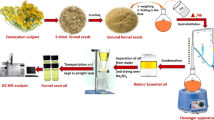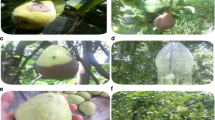Abstract
Basil (Ocimum basilicum L.) is an annual herb from the mint family. It is used as a fresh and dry spice, and in the form of essential oil. The antioxidant activity and antimicrobial properties of basil depend on genetic properties, environmental conditions, and growing technology. Therefore, the aim of this research was to determine the effects of mulching and irrigation on the antioxidant activity and antimicrobial properties of basil. The field experiment was conducted at Butmir, Bosnia and Herzegovina. The treatments used consisted of a combination of different mulches (wheat straw mulch, black mulch film, and control) and irrigation (irrigated and non-irrigated). Total phenolics, flavonoids, antioxidant activity, and essential oil antimicrobial activity were tested. Experimental results suggested that growing technology impacts the researched traits. The high content of total phenolic (69.94 mg GAE g−1), flavonoids (35.77 mg CAE g−1), and antioxidant activity (45.13 µM Fe2+ g−1) were recorded in the treatment with black mulch film. The research showed that the essential oil has a growth inhibition zone diameter of 10.88 mm for Salmonella spp. and 8.72 mm for E. coli.
Access this chapter
Tax calculation will be finalised at checkout
Purchases are for personal use only
Similar content being viewed by others
References
Gavrić, T., Marković, S., Čengić, L.: Factibility of growing basil as an alternative crop for adaptation to climate change in Bosnia and Herzegovina. Chil. J. Agric. Res. 83(1), 43–51 (2023). https://doi.org/10.4067/S0718-58392023000100043
Ciriello, M., et al.: Genotype and successive harvests interaction affects phenolic acids and aroma profile of Genovese basil for pesto sauce production. Foods 10, 278 (2021). https://doi.org/10.3390/foods10020278
Corrado, G., Chiaiese, P., Lucini, L., Miras-Moreno, B., Colla, G., Rouphael, Y.: Successive harvests affect yield, quality and metabolic profile of sweet basil (Ocimum basilicum L.). Agronomy 10(6), 830 (2020). https://doi.org/10.3390/agronomy10060830
Zagoto, M.: Biological activities of basil essential oil: a review of the current evidence. Res. Soc. Dev. 10, e363101220409 (2021)
Sarrou, E., Chatzopoulou, P., Koutsos, T.V., Katsiotis, S.T.: Herbagernyield and essential oil composition of sweet basil (Ocimum basilicum L.) under the influence of differentrnmulching materials and fertilizers. J. Med. Plants Stud. 4, 111–117 (2016)
Gavrić, T., et al.: Yield and contents of some bioactive components of basil (Ocimum basilicum L.) depending on time of cutting. Studia Universitatis Vasile Goldis Arad, Seria Stiintele Vieti 28, 192-197 (2018)
Zareen, A., Ahmed Gardezi, D., Naeemullah, M., Shahid Masood, M., Tahira, R.: Screening of antibacterial potential of siam queen, holy basil and italian basil essential oils. J. Med. Plants Stud. 2, 63–68 (2014)
Kaya, I., Yigit, N., Benli, M.: Antimicrobial activity of various extracts of Ocimum basilicum L. and observation of the inhibition effect on bacterial cells by use of scanning electron microscopy. Afr. J. Trad. Compl. Alt. Med. 5, 363–369 (2008)
Nazzaro, F., Fratianni, F., De Martino, L., Coppola, R., De Feo, V.: Effect of essential oils on pathogenic bacteria. Pharmaceuticals (Basel) 6, 1451–1474 (2013)
Albergaria, E.T., Oliveira, A.F.M., Albuquerque, U.P.: The effect of water deficit stress on the composition of phenolic compounds in medicinal plants. South African J. Bot. 131, 12–17 (2020)
Lebedev, V.G., Lebedeva, T.N., Vidyagina, E.O., Sorokopudov, V.N., Popova, A.A., Shestibratov, K.A.: Relationship between phenolic compounds and antioxidant activity in berries and leaves of raspberry genotypes and their genoty** by SSR markers. Antioxidants 11, 1961 (2022). https://doi.org/10.3390/antiox11101961
Šamec, D., Karalija, E., Šola, I., Vujčić Bok, V., Salopek-Sondi, B.: The role of polyphenols in abiotic stress response: the influence of molecular structure. Plants 10, 118 (2021). https://doi.org/10.3390/plants10010118
Ahmed, U., et al.: Expression profiling of flavonoid biosynthesis genes and secondary metabolites accumulation in populus under drought stress. Molecules 26, 5546 (2021). https://doi.org/10.3390/molecules26185546
Del Valle, J.C., Buide, M.L., Whittall, J.B., Valladares, F., Narbona, E.: UV radiation increases phenolic compound protection but decreases reproduction in Silene littorea. PLoS ONE 15, e0231611 (2020)
Sharma, A., Shahzad, B., Rehman, A., Bhardwaj, R., Landi, M., Zheng, B.: Response of phenylpropanoid pathway and the role of polyphenols in plants under abiotic stress. Molecules 24, 2452 (2019). https://doi.org/10.3390/molecules24132452
de la Portilla, N., et al.: Soil Amendment with biosolids and inorganic fertilizers: effects on biochemical properties and oxidative stress in Basil (Ocimum basilicum L.). Agronomy 10(8), 1117 (2020). https://doi.org/10.3390/agronomy10081117
Gavrić, T., et al.: Influence of meteorological parameters on the yield and chemical composition of common buckwheat (Fagopyrum esculentum Moench). J. Agric. For. 64, 113–120 (2018). https://doi.org/10.17707/agricultforest.64.4.13
Svecova, E., Neugebauerová, J.: A study of 34 cultivars of basil (Ocimum L.) and their morphological, economic and biochemical characteristics, using standardized descriptors. Acta Univ. Sapientiae, Aliment 3, 118–135 (2010)
Rakic, Z., Johnson, C.B.: Influence of environmental factors (including UV-B radiation) on the composition of the essential oil of Ocimum basilicum–sweet basil. J. Herbs Spices Med. Plants 9, 157–162 (2008). https://doi.org/10.1300/J044v09n02_22
Al-Huqail, A., et al.: Effects of climate temperature and water stress on plant growth and accumulation of antioxidant compounds in sweet basil (Ocimum basilicum L.) leafy vegetable. Scientifica 2020, 1–12 (2020). https://doi.org/10.1155/2020/3808909
Gavrić, T., Čengić, L., Marković, S.: Effects of cultivars on the yield and contents of some bioactive components of basil. Work Fac. Agric. Food Sci. 72, 20–27 (2022)
Iqbal, R., et al.: Potential agricultural and environmental benefits of mulches—a review. Bull Natl Res Cent 44, 75 (2020)
El-Beltagi, H.S., et al.: Mulching as a sustainable water and soil saving practice in agriculture: a review. Agronomy 12, 1881 (2022). https://doi.org/10.3390/agronomy12081881
Kashi, A., Hosseinzadeh, S., Babalar, M., Lessani, H.: Effect of black polyethylene mulch and calcium nitrate application on growth, yield, and blossom-end rot of watermelon, cv. charleston gray TT –
 (Blossom end rot)
(Blossom end rot)
 . JSTNAR 7, 1–10 (2004)
. JSTNAR 7, 1–10 (2004)Teame, G., Tsegay, A., Abrha, B.: Effect of organic mulching on soil moisture, yield, and yield contributing components of sesame (Sesamum indicum L.). Int. J. Agronomy 2017, 4767509 (2017). https://doi.org/10.1155/2017/4767509
Clevenger, J.F.: Apparatus for the determination of volatile oil. J. Am. Pharm. Assoc. 17, 345–349 (1928). https://doi.org/10.1002/jps.3080170407
Zhishen, J., Mengcheng, T., Jianming, W.: The determination of flavonoid contents in mulberry and their scavenging effects on superoxide radicals. Food Chem. 64, 555–559 (1999)
Benzie, I.F.F., Strain, J.J.: The ferric reducing ability of plasma (FRAP) as a measure of “Antioxidant Power”: the FRAP assay. Anal. Biochem. 239(1), 70–76 (1996). https://doi.org/10.1006/abio.1996.0292
Imamović, B., Komlen, V., Gavrić, T., Sunulahpašić, A., Lalević, B., Hamidović, S.: Antimicrobial activity of ginger (Zingiber officinale) and rosemary (Rosmarinus officinalis) essential oils. Agric. For. 67, 231–238 (2021)
Lim, J.H., Park, K.J., Kim, B.K., Jeong, J.W., Kim, H.J.: Effect of salinity stress on phenolic compounds and carotenoids in buckwheat (Fagopyrum esculentum M.) sprout. Food Chem. 135, 1065–1070 (2012)
Gavrić, T., et al.: Chemical composition and total phenols content of tartary buckwheat (Fagopyrum tataricum gaertn) grown in different vegetation seasons. In: Brka, M., Omanović-Mikličanin, E., Karić, L., Falan, V., Toroman, A. (eds.) 30th Scientific-Experts Conference of Agriculture and Food Industry: Answers for Forthcoming Challenges in Modern Agriculture, pp. 59–68. Springer International Publishing, Cham (2020). https://doi.org/10.1007/978-3-030-40049-1_7
Talbi, S., et al.: Effect of drought on growth, photosynthesis and total antioxidant capacity of the saharan plant Oudeneya africana. Environ. Exp. Bot. 176, 104099 (2020)
Chiappero, J., Cappellari, L.D.R., Palermo, T.B., Giordano, W., Banchio, E.: A simple method to determine antioxidant status in aromatic plants subjected to drought stress. Biochem. Mol. Biol. Educ. 49, 483–491 (2021)
Gharibi, S., Tabatabaei, B.E.S., Saeidi, G., Goli, S.A.H.: Effect of drought stress on total phenolic, lipid peroxidation, and antioxidant activity of achillea species. Appl. Biochem. Biotechnol. 178, 796–809 (2016)
Caliskan, O, et al.: The effects of salt and drought stress on phenolic accumulation in greenhouse-grown Hypericum pruinatum. Ital. J. Agron. 12(3) (2017). https://doi.org/10.4081/ija.2017.918
Carvalho, M., et al.: Drought stress effect on polyphenolic content and antioxidant capacity of cowpea pods and seeds. J. Agron. Crop Sci. 207, 197–207 (2021)
Dzida, K., Michałojć, Z., Jarosz, Z., Pitura, K., Skubij, N.: Effect of potassium fertilization on yield, growth and chemical composition of Basil herb. Acta Sci. Pol. Hortorum Cultus 17, 135–145 (2018)
Mulugeta, S.M., Radácsi, P.: Influence of drought stress on growth and essential oil yield of ocimum species. Horticulturae 8, 175 (2022). https://doi.org/10.3390/horticulturae8020175
Copolovici, L., Lupitu, A., Moisa, C., Taschina, M., Copolovici, D.M.: The effect of antagonist abiotic stress on bioactive compounds from basil (Ocimum basilicum). Appl. Sci. 11, 9282 (2021). https://doi.org/10.3390/app11199282
Ghasemi, K., Ghasemi, Y., Ebrahimzadeh, M.A.: Antioxidant activity, phenol and flavonoid contents of 13 citrus species peels and tissues. Pak. J. Pharm. Sci. 22(3), 277–281 (2009)
Swamy, M.K., Akhtar, M.S., Sinniah, U.R.: Antimicrobial properties of plant essential oils against human pathogens and their mode of action: an updated review. Evid. Based Complement Alternat. Med. 2016, 3012462 (2016)
Dzaferovic, A., et al.: Antimicrobial activity of three essential oils against several human pathogens. J. Environ. Treat. Tech. 7, 501–505 (2019)
Acknowledgements
This study was supported by grants from the Ministarstvo za nauku, visoko obrazovanje i mlade Kantona Sarajevo, B&H (Project name: Mogućnost uzgoja bosiljka kao alternativne culture u svrhu adaptacije klimatskim promjenama).
Author information
Authors and Affiliations
Corresponding author
Editor information
Editors and Affiliations
Rights and permissions
Copyright information
© 2023 The Author(s), under exclusive license to Springer Nature Switzerland AG
About this paper
Cite this paper
Šakonjić, A., Matijević, A., Hamidović, S., Čengić, L., Gavrić, T. (2023). Effects of Mulching and Irrigation on Antioxidant Activity and Antimicrobial Properties of Basil (Ocimum basilicum L.). In: Brka, M., et al. 32nd Scientific-Expert Conference of Agriculture and Food Industry. Agriconference 2022. Lecture Notes in Bioengineering. Springer, Cham. https://doi.org/10.1007/978-3-031-47467-5_6
Download citation
DOI: https://doi.org/10.1007/978-3-031-47467-5_6
Published:
Publisher Name: Springer, Cham
Print ISBN: 978-3-031-47466-8
Online ISBN: 978-3-031-47467-5
eBook Packages: Biomedical and Life SciencesBiomedical and Life Sciences (R0)





 (Blossom end rot)
(Blossom end rot)
 . JSTNAR 7, 1–10 (2004)
. JSTNAR 7, 1–10 (2004)